Blog & Latest Updates
Fly Fishing Articles
Insects by Common Name


Animal Kingdom Animalia (Animals)
Taxonomic Navigation -?-
Kingdom Animalia (Animals)
| Phylum in Animalia | ||
| AnnelidaWorms and Leeches | 0 | 2 |
| ArthropodaArthropods | 0 | 122 |
| ChordataVertebrates | 0 | 4 |
| Mollusca | 0 | 6 |
| PlatyhelminthesFlatworms | 0 | 0 |
Common Name
| Match | Common Name |
| Animals |
This is page 114 of specimens of Animalia. Visit the main Animalia page for:
- The behavior and habitat of Animalia.
- 131 underwater pictures of Animalia.
Pictures of 1264 Animal Specimens:
Atherix (Watersnipe Flies) True Fly Larva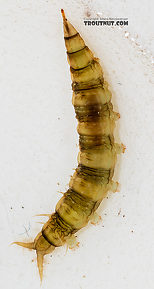 View 8 Pictures
View 8 Pictures
 View 8 Pictures
View 8 PicturesCollected July 2, 2019 from the Gallatin River in Montana
Added to Troutnut.com by Troutnut on July 18, 2019
Added to Troutnut.com by Troutnut on July 18, 2019
Ephemerella (Hendricksons, Sulphurs, PMDs) Mayfly Nymph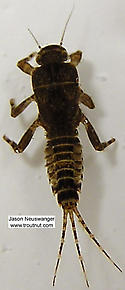 View 3 PicturesI confirmed with the microscope that this specimen has very small tubercles (
View 3 PicturesI confirmed with the microscope that this specimen has very small tubercles (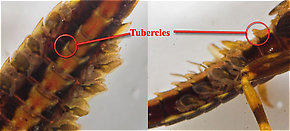 Tubercle: Various peculiar little bumps or projections on an insect. Their character is important for the identification of many kinds of insects, such as the nymphs of Ephemerellidae mayflies.), strongly double-banded tibiae (
Tubercle: Various peculiar little bumps or projections on an insect. Their character is important for the identification of many kinds of insects, such as the nymphs of Ephemerellidae mayflies.), strongly double-banded tibiae (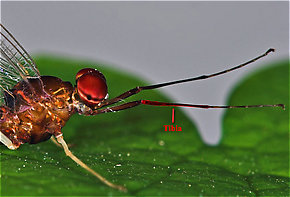 Tibia: A middle segments in the leg of an insect, located between the femur and the tarsus.), and a fan tail.
Tibia: A middle segments in the leg of an insect, located between the femur and the tarsus.), and a fan tail.
 View 3 PicturesI confirmed with the microscope that this specimen has very small tubercles (
View 3 PicturesI confirmed with the microscope that this specimen has very small tubercles (
A few (not all) of the abdominal tubercles on this Ephemerella needhami nymph are circled. They are especially large in this species.

The tibia of this Isonychia bicolor mayfly spinner is highlighted in red.
Collected March 10, 2004 from unknown in Wisconsin
Added to Troutnut.com by Troutnut on January 19, 2006
Added to Troutnut.com by Troutnut on January 19, 2006
Ephemerella invaria (Sulphur Dun) Mayfly Nymph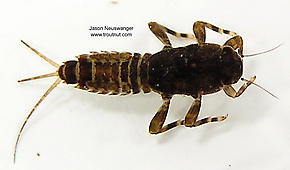 View 3 Pictures
View 3 Pictures
 View 3 Pictures
View 3 PicturesCollected March 10, 2004 from unknown in Wisconsin
Added to Troutnut.com by Troutnut on January 19, 2006
Added to Troutnut.com by Troutnut on January 19, 2006
Female Ephemerellidae (Hendricksons, Sulphurs, PMDs, BWOs) Mayfly Dun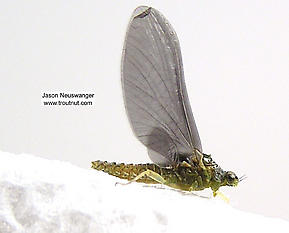 View 4 Pictures
View 4 Pictures
 View 4 Pictures
View 4 PicturesCollected August 4, 2004 from unknown in Wisconsin
Added to Troutnut.com by Troutnut on January 19, 2006
Added to Troutnut.com by Troutnut on January 19, 2006
Male Lepidostoma podagrum (Little Brown Sedge) Little Brown Sedge Adult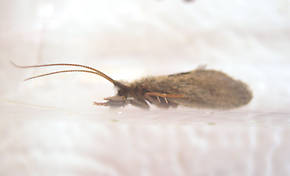 View 3 Pictures
View 3 Pictures
 View 3 Pictures
View 3 PicturesCollected May 12, 2011 from the Fall River in California
Added to Troutnut.com by Entoman on December 10, 2011
Added to Troutnut.com by Entoman on December 10, 2011
Male Cinygmula mimus Mayfly Spinner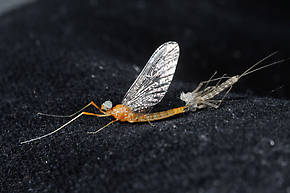 View 2 PicturesMale Cinygmula mimus spinner trapped in its subimago (Subimago: Mayfly nymphs emerge from the water into subimagoes, better known to anglers as "duns." They are a sexually immature, winged, recognizably adult stage and they must molt one more time into imagoes or "spinners" before they can mate.) skin, a cripple (Cripple: In fly fishing, a cripple is any insect which has been injured or deformed so that it cannot escape the water. This may include stillborn emergers or fully emerged adults which have been damaged, often by wind or waves, so that they can no longer fly. Trout often favor eating crippled insects.)??
View 2 PicturesMale Cinygmula mimus spinner trapped in its subimago (Subimago: Mayfly nymphs emerge from the water into subimagoes, better known to anglers as "duns." They are a sexually immature, winged, recognizably adult stage and they must molt one more time into imagoes or "spinners" before they can mate.) skin, a cripple (Cripple: In fly fishing, a cripple is any insect which has been injured or deformed so that it cannot escape the water. This may include stillborn emergers or fully emerged adults which have been damaged, often by wind or waves, so that they can no longer fly. Trout often favor eating crippled insects.)??
 View 2 PicturesMale Cinygmula mimus spinner trapped in its subimago (Subimago: Mayfly nymphs emerge from the water into subimagoes, better known to anglers as "duns." They are a sexually immature, winged, recognizably adult stage and they must molt one more time into imagoes or "spinners" before they can mate.) skin, a cripple (Cripple: In fly fishing, a cripple is any insect which has been injured or deformed so that it cannot escape the water. This may include stillborn emergers or fully emerged adults which have been damaged, often by wind or waves, so that they can no longer fly. Trout often favor eating crippled insects.)??
View 2 PicturesMale Cinygmula mimus spinner trapped in its subimago (Subimago: Mayfly nymphs emerge from the water into subimagoes, better known to anglers as "duns." They are a sexually immature, winged, recognizably adult stage and they must molt one more time into imagoes or "spinners" before they can mate.) skin, a cripple (Cripple: In fly fishing, a cripple is any insect which has been injured or deformed so that it cannot escape the water. This may include stillborn emergers or fully emerged adults which have been damaged, often by wind or waves, so that they can no longer fly. Trout often favor eating crippled insects.)??Collected June 3, 2012 from the Touchet River in Washington
Added to Troutnut.com by Bnewell on June 5, 2012
Added to Troutnut.com by Bnewell on June 5, 2012
Male Cinygmula par Mayfly Spinner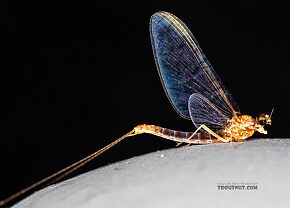 View 9 PicturesThis spinner came from one of those huge swarms that make one just stop fishing and admire the spectacle. Not bad for a little-known species.
View 9 PicturesThis spinner came from one of those huge swarms that make one just stop fishing and admire the spectacle. Not bad for a little-known species.
In the same swarm I collected a female and another male.
 View 9 PicturesThis spinner came from one of those huge swarms that make one just stop fishing and admire the spectacle. Not bad for a little-known species.
View 9 PicturesThis spinner came from one of those huge swarms that make one just stop fishing and admire the spectacle. Not bad for a little-known species.In the same swarm I collected a female and another male.
Collected July 4, 2020 from Mystery Creek #249 in Washington
Added to Troutnut.com by Troutnut on July 12, 2020
Added to Troutnut.com by Troutnut on July 12, 2020
Female Drunella grandis (Western Green Drake) Mayfly Dun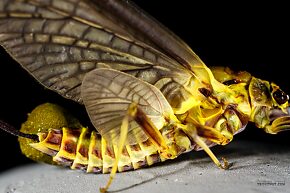 View 7 PicturesI didn't find a male spinner to associate with this one; I'm tentatively calling it grandis based on size alone. I found it floating down the surface of the Henry's Fork (the only one I saw that day, weeks after the hatch probably peaked) crippled by what appears to be a mass of eggs sticking out of its abdomen.
View 7 PicturesI didn't find a male spinner to associate with this one; I'm tentatively calling it grandis based on size alone. I found it floating down the surface of the Henry's Fork (the only one I saw that day, weeks after the hatch probably peaked) crippled by what appears to be a mass of eggs sticking out of its abdomen.
 View 7 PicturesI didn't find a male spinner to associate with this one; I'm tentatively calling it grandis based on size alone. I found it floating down the surface of the Henry's Fork (the only one I saw that day, weeks after the hatch probably peaked) crippled by what appears to be a mass of eggs sticking out of its abdomen.
View 7 PicturesI didn't find a male spinner to associate with this one; I'm tentatively calling it grandis based on size alone. I found it floating down the surface of the Henry's Fork (the only one I saw that day, weeks after the hatch probably peaked) crippled by what appears to be a mass of eggs sticking out of its abdomen.Collected August 1, 2020 from the Henry's Fork of the Snake River in Idaho
Added to Troutnut.com by Troutnut on August 18, 2020
Added to Troutnut.com by Troutnut on August 18, 2020
Ameletus (Brown Duns) Mayfly Nymph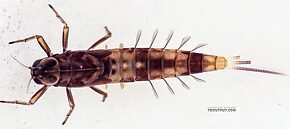 View 6 PicturesI spent (Spent: The wing position of many aquatic insects when they fall on the water after mating. The wings of both sides lay flat on the water. The word may be used to describe insects with their wings in that position, as well as the position itself.) ages trying to identify this one but ultimately couldn't narrow it down to species. I'm guessing it's either a species that has not yet been reported from Idaho or a species with some variation in characteristics not accounted for in the current key (Zloty 1997), which is only for Alberta but happens to contain all the species documented in Idaho except for one (which is rare and only in a different part o the state from this one).
View 6 PicturesI spent (Spent: The wing position of many aquatic insects when they fall on the water after mating. The wings of both sides lay flat on the water. The word may be used to describe insects with their wings in that position, as well as the position itself.) ages trying to identify this one but ultimately couldn't narrow it down to species. I'm guessing it's either a species that has not yet been reported from Idaho or a species with some variation in characteristics not accounted for in the current key (Zloty 1997), which is only for Alberta but happens to contain all the species documented in Idaho except for one (which is rare and only in a different part o the state from this one).
Here are my raw notes from the microscope session:
8. Ameletus nymph (genus 100 % based on mouth parts under microscope)
1. This is probably a species with the nymph either not described yet or not reported in Idaho (or Alberta).
2. There is a key to the species of nymphs in Alberta (Zloty 1997) which includes all but one (A. tolae) of the species listed in Idaho by IDFG (https://idfg.idaho.gov/species/taxa/8607), and A. tolae is only listed from one drainage in north-central Idaho. So my specimen should be in that key. However, it doesn’t fit any of them.
1. The antennae are pale with brown at the apex (Apex: The uppermost, outermost, or culminating point; the tip.). This doesn’t fit any of the species they described.
2. The labrum (Labrum: The platelike structure forming the roof of the mouth of insects; the upper lip.) is almost completely dark brown, maybe a bit paler toward the apex (Apex: The uppermost, outermost, or culminating point; the tip.).
3. Following the key in Zloty 1997 basically rules out every species reported in Idaho except for tolae, which would be outside its range:
1. Couplet 1 : There definitely aren’t strong ganglionic markings on sternites (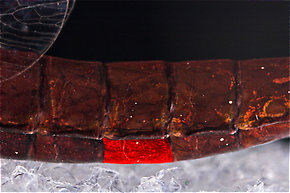 Sternite: The bottom (ventral) part of a single segment on an insect's abdomen.) 2-8 (100 % rules out similior and celer) —> 3
Sternite: The bottom (ventral) part of a single segment on an insect's abdomen.) 2-8 (100 % rules out similior and celer) —> 3
2. Couplet 3 : Posterior (Posterior: Toward the back of an organism's body. The phrase "posterior to" means "in back of.") margins of sternites ( Sternite: The bottom (ventral) part of a single segment on an insect's abdomen.) 6-8 lack large spines (80 % sure) but other characteristics rule out the species if there were spines (validus, oregonensis, subnotatus) —> 6
Sternite: The bottom (ventral) part of a single segment on an insect's abdomen.) 6-8 lack large spines (80 % sure) but other characteristics rule out the species if there were spines (validus, oregonensis, subnotatus) —> 6
3. Couplet 6 : Mesal (Mesal: Toward the middle.) gill extension present, but pretty slim… similar to Fig. 23B or 23G —> 7
4. Couplet 7 : Obviouly gos to 8
5. Couplet 8 : Small size and time of year rules out velox, tergite (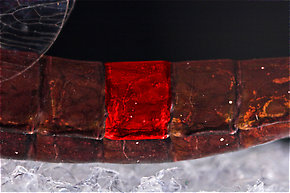 Tergite: The top (dorsal) part of a single segment on an insect's abdomen when it consists of a single chitinous plate (sclerite), or an individual sclerite if the segment has more than one.) patterna and gill shape rules out pritchardi (which is not reported in Idaho anyway). Additional features (antennae, labrum (Labrum: The platelike structure forming the roof of the mouth of insects; the upper lip.) color) rule out a small velox.
Tergite: The top (dorsal) part of a single segment on an insect's abdomen when it consists of a single chitinous plate (sclerite), or an individual sclerite if the segment has more than one.) patterna and gill shape rules out pritchardi (which is not reported in Idaho anyway). Additional features (antennae, labrum (Labrum: The platelike structure forming the roof of the mouth of insects; the upper lip.) color) rule out a small velox.
6. Backtrack to call the mesal (Mesal: Toward the middle.) gill extension “well developed” —> 9
7. Couplet 9 : Tail coloration obviously —> 10
8. Couplet 10 : Supposing it’s a small specimen of a “larger species” leads to 11, in which femora (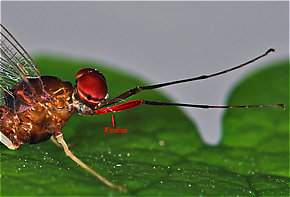 Femur: The main segment of an insect's leg close to the body, in between the tibia and the trochanter.) coloration and timing rule out vernalis, and color pattern rules out bellulus. Mesal (Mesal: Toward the middle.) extension on gills from species description very conclusively rules out bellulus. Therefore, calling it a “smaller species” is the correct path —> 12
Femur: The main segment of an insect's leg close to the body, in between the tibia and the trochanter.) coloration and timing rule out vernalis, and color pattern rules out bellulus. Mesal (Mesal: Toward the middle.) extension on gills from species description very conclusively rules out bellulus. Therefore, calling it a “smaller species” is the correct path —> 12
9. Couplet 12 : Sternites ( Sternite: The bottom (ventral) part of a single segment on an insect's abdomen.) without well-defined longitudinal stripe —> cooki. However, tergite (
Sternite: The bottom (ventral) part of a single segment on an insect's abdomen.) without well-defined longitudinal stripe —> cooki. However, tergite ( Tergite: The top (dorsal) part of a single segment on an insect's abdomen when it consists of a single chitinous plate (sclerite), or an individual sclerite if the segment has more than one.) color patterns don’t even come close to matching ANY of the 3 species from this point on (cooki, sparsatus, suffusus). From the species descriptions:
Tergite: The top (dorsal) part of a single segment on an insect's abdomen when it consists of a single chitinous plate (sclerite), or an individual sclerite if the segment has more than one.) color patterns don’t even come close to matching ANY of the 3 species from this point on (cooki, sparsatus, suffusus). From the species descriptions:
1. cooki: Antenna and labrum (Labrum: The platelike structure forming the roof of the mouth of insects; the upper lip.) colors don’t fit. Mesal (Mesal: Toward the middle.) extension should be larger and tracheation lighter, to be this species.
2. sparsatus: Antenna and labrum (Labrum: The platelike structure forming the roof of the mouth of insects; the upper lip.) colors don’t fit. Mesal (Mesal: Toward the middle.) extension should be larger. Postero-lateral (Lateral: To the side.) spines should be very prominent, not barely noticeable.
3. suffusus: Also bad fit to antenna and labrum (Labrum: The platelike structure forming the roof of the mouth of insects; the upper lip.) colors, mesal (Mesal: Toward the middle.) extension, and especially gill tracheation.
 View 6 PicturesI spent (Spent: The wing position of many aquatic insects when they fall on the water after mating. The wings of both sides lay flat on the water. The word may be used to describe insects with their wings in that position, as well as the position itself.) ages trying to identify this one but ultimately couldn't narrow it down to species. I'm guessing it's either a species that has not yet been reported from Idaho or a species with some variation in characteristics not accounted for in the current key (Zloty 1997), which is only for Alberta but happens to contain all the species documented in Idaho except for one (which is rare and only in a different part o the state from this one).
View 6 PicturesI spent (Spent: The wing position of many aquatic insects when they fall on the water after mating. The wings of both sides lay flat on the water. The word may be used to describe insects with their wings in that position, as well as the position itself.) ages trying to identify this one but ultimately couldn't narrow it down to species. I'm guessing it's either a species that has not yet been reported from Idaho or a species with some variation in characteristics not accounted for in the current key (Zloty 1997), which is only for Alberta but happens to contain all the species documented in Idaho except for one (which is rare and only in a different part o the state from this one).Here are my raw notes from the microscope session:
8. Ameletus nymph (genus 100 % based on mouth parts under microscope)
1. This is probably a species with the nymph either not described yet or not reported in Idaho (or Alberta).
2. There is a key to the species of nymphs in Alberta (Zloty 1997) which includes all but one (A. tolae) of the species listed in Idaho by IDFG (https://idfg.idaho.gov/species/taxa/8607), and A. tolae is only listed from one drainage in north-central Idaho. So my specimen should be in that key. However, it doesn’t fit any of them.
1. The antennae are pale with brown at the apex (Apex: The uppermost, outermost, or culminating point; the tip.). This doesn’t fit any of the species they described.
2. The labrum (Labrum: The platelike structure forming the roof of the mouth of insects; the upper lip.) is almost completely dark brown, maybe a bit paler toward the apex (Apex: The uppermost, outermost, or culminating point; the tip.).
3. Following the key in Zloty 1997 basically rules out every species reported in Idaho except for tolae, which would be outside its range:
1. Couplet 1 : There definitely aren’t strong ganglionic markings on sternites (

One sternite of this Isonychia bicolor mayfly spinner is highlighted in red.
2. Couplet 3 : Posterior (Posterior: Toward the back of an organism's body. The phrase "posterior to" means "in back of.") margins of sternites (

One sternite of this Isonychia bicolor mayfly spinner is highlighted in red.
3. Couplet 6 : Mesal (Mesal: Toward the middle.) gill extension present, but pretty slim… similar to Fig. 23B or 23G —> 7
4. Couplet 7 : Obviouly gos to 8
5. Couplet 8 : Small size and time of year rules out velox, tergite (

One tergite of this Isonychia bicolor mayfly spinner is highlighted in red.
6. Backtrack to call the mesal (Mesal: Toward the middle.) gill extension “well developed” —> 9
7. Couplet 9 : Tail coloration obviously —> 10
8. Couplet 10 : Supposing it’s a small specimen of a “larger species” leads to 11, in which femora (

The femur of this Isonychia bicolor mayfly spinner is highlighted in red.
9. Couplet 12 : Sternites (

One sternite of this Isonychia bicolor mayfly spinner is highlighted in red.

One tergite of this Isonychia bicolor mayfly spinner is highlighted in red.
1. cooki: Antenna and labrum (Labrum: The platelike structure forming the roof of the mouth of insects; the upper lip.) colors don’t fit. Mesal (Mesal: Toward the middle.) extension should be larger and tracheation lighter, to be this species.
2. sparsatus: Antenna and labrum (Labrum: The platelike structure forming the roof of the mouth of insects; the upper lip.) colors don’t fit. Mesal (Mesal: Toward the middle.) extension should be larger. Postero-lateral (Lateral: To the side.) spines should be very prominent, not barely noticeable.
3. suffusus: Also bad fit to antenna and labrum (Labrum: The platelike structure forming the roof of the mouth of insects; the upper lip.) colors, mesal (Mesal: Toward the middle.) extension, and especially gill tracheation.
Collected August 4, 2020 from Green Lake Outlet in Idaho
Added to Troutnut.com by Troutnut on August 20, 2020
Added to Troutnut.com by Troutnut on August 20, 2020
Female Baetis tricaudatus (Blue-Winged Olive) Mayfly Dun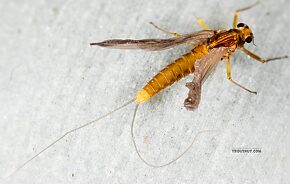 View 6 PicturesThis one emerged from a nymph of this kind in my studio but got a bit waterlogged before I could pull it out to photograph.
View 6 PicturesThis one emerged from a nymph of this kind in my studio but got a bit waterlogged before I could pull it out to photograph.
 View 6 PicturesThis one emerged from a nymph of this kind in my studio but got a bit waterlogged before I could pull it out to photograph.
View 6 PicturesThis one emerged from a nymph of this kind in my studio but got a bit waterlogged before I could pull it out to photograph.Collected September 12, 2020 from the Yakima River in Washington
Added to Troutnut.com by Troutnut on September 19, 2020
Added to Troutnut.com by Troutnut on September 19, 2020
Top 10 Fly Hatches
Top Gift Shop Designs
Eat mayflies.
Top Insect Specimens
Miscellaneous Sites
Troutnut.com is copyright © 2004-2024 Jason
Neuswanger (email Jason). See my FAQ for information about use of my images.
 privacy policy
privacy policy
